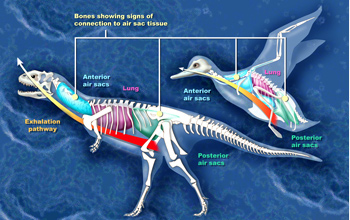Multimedia Gallery
Pulmonary air-sac systems of dinosaurs and birds exhibit striking similarities
The pulmonary air-sac systems of dinosaurs and birds exhibit striking similarities, including predicted regions air of sac integration into the skeleton. The air sacs act like bellows to move air through the rigid lungs.
Theories about animals' relatedness were first proposed in the late 19th century but soon fell out of favor. Evidence gathered over the past 30 years, however, has breathed new life into the hypothesis.
The work of two National Science Foundation-supported researchers makes clear the unique pulmonary system of birds, which has fixed lungs and air sacs that penetrate the skeleton, has an older history than previously realized. It also dispels the theory that predatory dinosaurs had lungs similar to living reptiles, like crocodiles.
This image accompanied NSF press release, "Study Documents Bird-like Breathing Systems in Long-extinct Dinosaurs."
Credit: Nicolle Rager Fuller, National Science Foundation
Images and other media in the National Science Foundation Multimedia Gallery are available for use in print and electronic material by NSF employees, members of the media, university staff, teachers and the general public. All media in the gallery are intended for personal, educational and nonprofit/non-commercial use only.
Images credited to the National Science Foundation, a federal agency, are in the public domain. The images were created by employees of the United States Government as part of their official duties or prepared by contractors as "works for hire" for NSF. You may freely use NSF-credited images and, at your discretion, credit NSF with a "Courtesy: National Science Foundation" notation.
Additional information about general usage can be found in Conditions.
Also Available:
Download the high-resolution JPG version of the image. (839 KB)
Use your mouse to right-click (Mac users may need to Ctrl-click) the link above and choose the option that will save the file or target to your computer.

 All images in this series
All images in this series